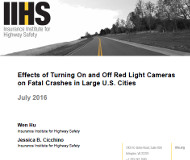8/4/2016
OPINION: The Insurance Industry Hit And RunAn analysis of the insurance industry study claiming the removal of red light cameras causes deaths.

Dozens of news outlets around the country last week carried Joan Lowy's Associated Press wire story bearing the banner headline "study finds red light cameras save lives." Lowy was reporting on the Insurance Institute for Highway Safety's (IIHS) latest report claiming that terminating a red light camera program "costs lives." Like so many of the insurance industry's reports, this latest study on closer examination appears to be more public relations effort than scientific undertaking.
IIHS has a direct financial stake in the outcome of its research into photo enforcement. The organization is funded by the major US insurance companies. In states like California and Arizona, photo tickets carry points, which means each time one is issued, the benefactors of IIHS raise insurance rates and generate additional profit.
The new study performed by IIHS vice president for research Jessica B. Cicchino, a psychologist, and Wen Hu, an engineer, reflects the financial interests of IIHS. This can readily be seen in its accompanying press release, which lifted loaded language directly from red light camera industry press statements. Numerous press accounts quote American Traffic Solutions spokesman Charles Territo referring to those who oppose cameras as the "vocal minority," and the same phrase is found throughout Redflex annual reports and official statements. IIHS copied the industry rhetoric verbatim.
"Although surveys have found strong support for red light cameras in communities that have them, opposition from a vocal minority has led some jurisdictions to shut off their cameras," the July 28 IIHS press release stated.
The problem with using such rhetoric is that it is factually incorrect. A total of thirty-six cities have put the question of red light and speed cameras on a direct ballot, and on thirty-two occasions a majority of the public terminated the camera program (view complete list). In fifteen of those election contests, the electoral majority proved to be two-thirds or more against the cameras.
The most troubling aspect of the IIHS study is that it did not actually analyze the question that it claimed to examine. Insurance industry researchers did not compare before and after accident rates at photo enforced intersections in cities that terminated red light camera programs. Instead, they compared the citywide number of fatal accidents in 57 large jurisdictions with red light camera programs to 33 cities without them. They then compared fatal accidents in 19 cities that deactivated cameras to 31 that kept their cameras rolling.
Fatal intersection accidents are relatively rare. In Texas, for instance, intersection fatalities (not necessarily caused by red light running) accounted for 6 percent of all serious accidents last year. Under the IIHS methodology, a camera city could perform a significant engineering upgrade at a camera-free intersection, but the resulting safety benefit would be credited to the red light cameras. Nonetheless, safety continuously improved in the cities that did not use red light cameras.
"The rate of fatal red light running crashes significantly decreased by 1.9 percent per year since 1992 in cities with no cameras," the IIHS study admitted.
So to claim the reduction in accidents was an "increase," IIHS applied an undisclosed formula to "interpret" the result of turning the cameras off in light of factors such as unemployment rates and land use patterns. The conclusion was that terminating camera programs resulted in a citywide fatal intersection accident rate that was 16.1 percent "higher than what would have been expected with cameras on." IIHS does not provide the underlying data that would allow the IIHS expectation to be replicated or otherwise verified.
IIHS produced the very first study that asserted red light cameras were associated with safety benefits. This document was authored by Richard Retting, the man who brought red light camera in the United States and is now a paid "partner" of red light camera vendor Brekford. The Florida Public Health Association journal reviewed Retting's IIHS work and found major statistical flaws. Numerous studies performed by organizations without a financial stake in the photo enforcement questions have concluded the use of cameras produce mixed or negative results (view independent studies).
The Associated Press committed a fundamental journalistic error in failing to seek independent comment that would give a fuller picture of the red light camera controversy. While Lowy's story does quote AAA research director Jake Nelson, AAA is one of the most prominent members of IIHS. From 2011-2013, AAA's Steve George served as chairman of the IIHS board. As such, AAA shares the insurance industry's financial motives and has heavily lobbies state lawmakers around the country to encourage the installation of more red light cameras and speed cameras.
A copy of the IIHS study is available in a 1mb PDF file at the source link below.


